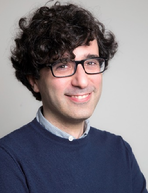 This thesis investigates the removal - and removal mechanisms - of engineered nanomaterials and nanoparticles in drinking water treatment plants. The potential release into aquatic environments, raises concerns on the security of resources used for drinking water production.
This thesis investigates the removal - and removal mechanisms - of engineered nanomaterials and nanoparticles in drinking water treatment plants. The potential release into aquatic environments, raises concerns on the security of resources used for drinking water production.
‘In our experiments, we used real surface waters,’ Roberto Floris says. ‘We focused on how these potential pollutants affect process performances, and which treatments are best to be followed for removal.’
In this thesis membrane filtration processes have received considerable attention. At first the role of membrane pore sizes was investigated. Under typical full-scale operational conditions, it was shown that nC60 removal was completely obtained by membranes with smaller pore sizes than the particle.
‘Steric exclusion is the main mechanism here,’ thus Roberto. ‘For larger pore sizes the combination of pore blocking and cake layer formation, plays an important role, on both particle removal and membrane performance.’
In the following chapter, a remarkable synergistic effect on membrane fouling between nanoparticles and surface water constituents was reported: the nanoparticles may fill the void spaces between the natural organic matter deposited on the membrane surface. 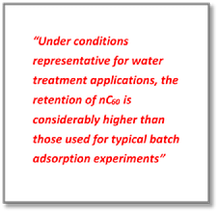
‘This may lead to a lower cake porosity and therefore higher filtration resistance,’ Roberto concludes. However, the same synergistic effect was not observed during the filtration of gold and silver nanoparticles (both on pilot and lab scale), most likely because of the different characteristics of the nanoparticles and the organics present in the water.
Further this thesis reports on the removal (mechanisms) of nC60 in coagulation-flocculation-sedimentation processes, using ferric chloride as a coagulant. Also the removal effectiveness of nC60 using activated carbon was investigated.
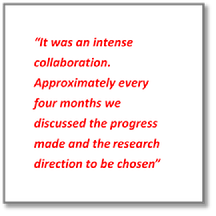
‘Under conditions representative for water treatment applications, the retention of nC60 is considerably higher than those used for typical batch adsorption experiments,’ Roberto says. ‘Kinetic and destabilizing effects during filtration should be included, in order to understand the actual phenomena occurring in daily practice.’
NanoNext NL
Roberto Floris’ PhD project was part of the NanoNext NL program, and was carried out at the KWR Watercycle Research Institute, together with the partners: Waterbedrijf Vitens, Pentair/X Flow.
‘It was an intense collaboration. Approximately every four months we discussed the progress made and the research direction to be chosen,’ Roberto says. ‘Apart from the feedback and expertise I shared with the industrial partners, I had full access to a wide range of membrane types to be investigated. Even pilot scale validation experiments could be performed. Together with the partners - and in full agreement with Professor Kitty Nijmeijer (Membrane Science & Technology Group now at TUe) and dr. Emile Cornelissen (from KWR Watercycle Research Institute) - we realised the outlined PhD project plan.’
Experimental
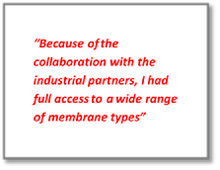
Roberto characterizes his PhD work as mostly experimental in nature. ‘Further, modelling was used for experimental data interpretation,’ he says.
Roberto: ‘Publications resulted in Water Research Journal. Two more papers are under submission and revision at this very moment. During my PhD work I felt like acting as a mediator, between the  academic world and the applied sciences. This was an instructive experience, matching with this kind of PhD projects, and it was preparatory in view of my future job. Interesting and relevant results I achieved as well, to be important for future daily water treatment praxis.’
academic world and the applied sciences. This was an instructive experience, matching with this kind of PhD projects, and it was preparatory in view of my future job. Interesting and relevant results I achieved as well, to be important for future daily water treatment praxis.’
Future job
As a civil engineer by origin, Roberto learnt a great deal on fundamental nanotechnology, especially in the first part of his PhD project, following Mesa+ workshops on the topic.
While still working on his PhD Defence talk, Roberto already finds himself employed as a scientist at PWNT, a water-technologies company wholly owned by the Dutch water utility PWN (Provinciaal Waterbeheer Noord-Holland in Velserbroek).
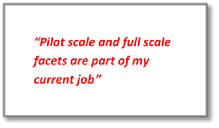
Roberto: ‘The subject is related to my PhD topic. I am working on ceramic microfiltration membranes and novel fouling controlling strategies. So, the work is not confined to one contaminant (nanoparticles) anymore. Also more pilot scale and full scale facets are part of my job now. I really benefited from the project approach I learnt to handle during my PhD work, as this project also was complex and composite, urging one to organise your work, and yourself, to a great extent.’
